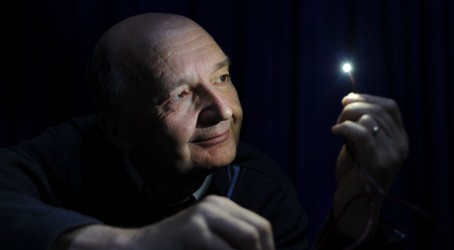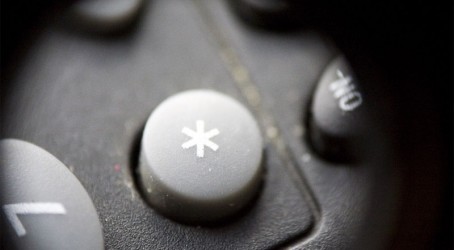Imagine switching on the light in your living room and simultaneously activating an ultra-high-speed broadband link. As the light illuminates the room it also bathes it in information. Uploading and downloading information from the internet happens in a flash.
Harald Haas, professor of mobile communications at the University of Edinburgh, is developing technology that can do exactly this. In the laboratory he and his team have produced what is said to be the world’s fastest realtime data transmission system. It can transmit and download streamed video at a rate of 130Mb/s using visible light. By comparison, the average domestic broadband connection in the UK works at 9Mb/s, according to the telecoms watchdog Ofcom.
The technology, known as li-fi, uses LEDs as a source of light to transmit the data wirelessly. Haas says: “LEDs are electronic devices that are a little bit like a transistor and as a consequence they can be switched on and off very quickly.” The pattern of this flashing light can project the data in the form of 0s and 1s at very high speeds. The data is encoded in the light and transmitted from the light source.
He adds: “You are not really switching the light on and off, you are changing the intensity in a very subtle and specific way.” The light then hits a sensitive photosensor that decodes the data. It does this by creating an output current that varies in response to the changing intensity of light. The changes are so fast that they are invisible to the human eye.
Wireless data is normally transmitted by radio waves. But the radiofrequency spectrum has only a limited number of wavelengths, which are becoming increasingly congested as more and more commercial applications jostle for space. Radio bands are also heavily regulated by telecoms bodies and can be expensive.
Haas explains that the radiofrequency spectrum available in the home is “very limited” and this restricts the rate at which data can be transmitted. And in places such as hotels where many wi-fi access points are installed, transmission rates fall and services are delayed if lots of people connect. Haas explains: “That effect is caused by interference. The radiofrequency signal goes through walls, so the signal from one room will interfere with that in another room.”
By contrast, light signals do not penetrate physical barriers or interfere with radio waves. The light spectrum is also unrestricted and is 10,000 times larger than the radiofrequency spectrum, so potentially providing space for the world’s growing bandwidth needs.Networking company Cisco says that the amount of data transmitted through wireless networks doubles every year. It predicts that by 2016 data traffic on the internet, managed IP and mobile systems will reach 1.3 zettabytes.
Using li-fi would mean that each room would need an enabled light source. Haas explains: “Light bulbs are connected to the power line infrastructure so we don’t have to wire up these new access points. We just use the existing infrastructure to create a new wireless network that will be able to supply this increasing demand for wireless data traffic.” In the laboratory, Haas and his colleagues are now working towards achieving speeds of 1Gb/s. “We know this is feasible,” he says.
His spin-out company Pure VLC is now working to commercialise the technology. It hopes to have its first product available for sale by the end of the year. Known as a “smart lighting development kit,” it will be capable of downloading and uploading data at speeds of between 15 and 50Mb/s.

Dr Brian Sadler, a fellow of the US Army Research Laboratory, says that li-fi devices potentially represent a “pot of gold”. He adds that the technology is likely to be a “game changer” within its domain. “It scales up really well.”
He says that the ability to transmit data by light has been feasible for decades. The issues with commercialising the technology come down to the business model because the light can only carry data in the line of sight. “But there is a lot of commercial stuff on the drawing board,” he says.
Sadler is researching the possible applications of light communications in defence. He explains: “There is this inherent ability of light to be very confined from point A to point B, which makes it very difficult for anyone to mess with it in terms of interception. But you generally need line of sight and you need to be able to point and track.” As light beams cannot penetrate barriers, it is generally a supplementary technology that can be used in addition to radio.
On a larger scale, lasers can be used to transmit high rates of data between satellites in space or to dishes on the ground. Such systems can allow military or telecoms information to pass between two towers or from space to the earth.
Sadler says: “You have to point the light beam very precisely. Transmitting by satellite is extremely point sensitive.” This calls for a feedback and control circuit that can maintain the line of sight between the two devices. These systems often prove more challenging than the laser technology itself, he adds.
In the future it may be possible to design military vehicles with antennas that can talk to satellites using light communication. He says: “You can envisage rolling out a satellite dish and alongside that have radios that talk locally to a base station, which is connected to a satellite dish. Then I have effectively got a local network that can go out on a satellite network – that is appealing to the military.”
Haas says that light communication could be used where radio waves cannot travel, for example underwater to pass information between submarines. He says: “It could also be used in hospitals where classic radio frequency is not permitted or in petrochemical plants.”
Haas is also working with other companies in a variety of industries on projects to commercialise visible light communication technology. But he remains tightlipped about the ventures.
Roger Green, professor of electronic communication systems at the University of Warwick, is working on optical wireless technologies for the automotive industry. He says that the technology could be used to remove some of the wires under the bonnets of cars, making vehicles lighter and more fuel efficient. Green says: “The benefit of this, especially for petrol engines, is that it is completely immune from electromagnetic interference that can come from spark plugs.”
In fact some cars already use optoelectronic devices as part of an electrical ignition system. But more widespread use of optical wireless technology could allow engine management systems to send information to and from different parts of the engine.
Using optical data transmission, additional measurements of the engine speed could be taken to better control the ignition. Or more measurements of wheel speed, temperature and spin could be taken for anti-lock braking. The light could transmit data by travelling through air-conditioning ducts or bouncing down the panels of the car body.
Traditionally, such data are transported by wires. Getting rid of these could increase the amount of information that can be collected from the components of the car, making it more reliable. “You could have a more intelligent vehicle because you could make more measurements and have the capacity for sending far greater amounts of information all around,” says Green.
“You could even have smart skins on vehicles, a thin film of optical conduit, so that if the bodywork is flexing or stressing it could send information back to the engine management system. Potentially, you could provide the driver and the vehicle management system with much more information to operate the car.”
He says that one day traffic lights could send out optical signals to cars, relaying information about driving conditions. Other researchers at the University of Warwick are working on optical systems that can send multimedia information to passengers’ phones or personal devices from the ceiling lights.
Green adds that optical wireless technology also holds potential for the aerospace industry. “There is a huge amount of wiring in an aircraft, and if you can replace even a small percentage of that it would save an awful lot of fuel because of the weight saving.”

Making light work of communication in the home
There are already applications of optical wireless technology in homes. The remote control that we use to change the channel on the television is one. Pushing a button on the remote control activates an LED positioned on the top of the device that sends a signal to the TV by an invisible infrared light beam. The beam carries a series of pulses that encode a specific instruction, which a processor in the TV decodes.
An optical computer mouse works in a similar way. It uses infrared LEDs to detect the movement of the mouse relative to the surface it sits on. A processor then translates this information and sends it to the computer.
Many homes now receive their broadband signals from a fibre-optic connection. An optical fibre is a thin tube of glass or plastic that carries light from one end to another. The information is sent through the fibres as a series of light pulses. The high frequency of light means that information can be sent quickly, so download speeds are faster than with conventional broadband.